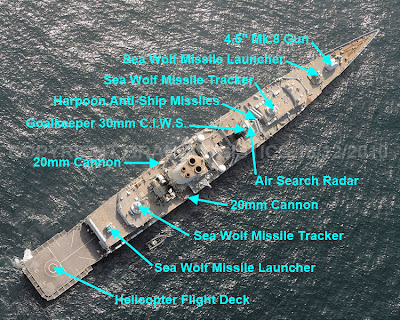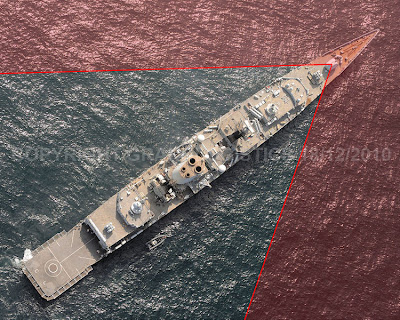In the days when a warship's armament consisted almost entirely of turret mounted guns,firing arcs were a subject of great importance.
Today weapon firing arcs are still important but ship designers must also consider sensor arcs.
As targets must be detected and tracked before they may be engaged,sensor positioning takes precedence over weapon positioning.
Many weapons can fire over the horizon but most sensors are directional and must be mounted high in the ship to extend their horizon.
Fortunately,sensors are usually lighter than weapons and consequently can often be carried on tall masts which give them both all round coverage and a distant horizon.
There are also some weapons to which firing arcs do not apply such as some missiles fired upwards from vertical launch systems.
These may rise high enough to clear a ship's masts before manoeuvring towards the target.
On board a warship,weapons and sensors must compete for space with communications and electronic warfare systems.
Some of these are directional and need clear arcs while others,such as satellite and High Frequency communications are less affected by such constraints in the horizontal plane as they receive signals largely from above.
For the sake of simplicity we shall not consider such systems further here.
We shall also neglect discussion of underwater systems for the sake of brevity.
A modern warship is likely to carry a helicopter and this requires an unimpeded approach.
In the event of a mishap,a stern mounted flightdeck is desirable as this is safer for both the ship and helicopter.
Notice how the helicopter sets the flightdeck on fire in the above video,all of the crew survived this accident.
The layout of a typical surface combatant,the British Type 22 Frigate Her Majesty's Ship (H.M.S.) Cumberland,can be seen above.
The ship's major weapon systems can be seen above.
In the days when a ships weapons consisted primarily of turreted guns,the Royal Navy used a system to label warship gun turrets.
The above picture illustrates this system as applied to the modern frigate H.M.S.Cumberland.
Forward positions were labelled A,B,C etc. starting at the bows and working back.
Positions aft were labelled Y,X,W etc. working forward from the stern.
In the centre of the ship positions were labelled P,Q,R, etc. working back from the bridge.
Positions on the port side of the ship were labelled P1,P2,P3 working backwards from the bows.
Positions on the starboard side of the ship were labelled S1,S2,S3 etc. working back from the bows.
Here we have applied the system not only to gun turrets but also to sensor turrets,missile launchers and the helicopter flightdeck.
The unobstructed all round coverage of a radar mounted on a tall mast is illustrated above.
The ship's helicopter can approach from astern or alongside giving it a 180 degree approach arc to the flight deck.
The firing arc of the Goalkeeper Close In Weapon System (C.I.W.S.) is restricted by it's close proximity to the forward mast.
It is also restricted by the Sea Wolf tracker mounted in front of it.
Side mounted 20mm cannons have very poor firing arcs restricted by the ship's superstructure.
Earlier Batches of Type 22 frigates had their cannons mounted on the bridge wings where they had slightly better firing arcs.
Firing arcs for the main gun are significantly restricted by the ship's superstructure..
The forward superstructure is slightly chamfered at the sides which reduces this restriction to some extent.
The ship's freedom to manoeuvre in combat is reduced by this restriction as it must keep targets within it's firing arc.
The arcs of the forward Sea Wolf missile launcher are similarly restricted by superstructure.
It can be seen from this picture that the superstructure has been chamfered specifically to increase the Sea Wolf firing arc.
The superstructure forward of the aft Sea Wolf launcher also has chamfered edges to mitigate it's restriction on missile firing arcs.
Note how chamfers have to be asymmetrical due to the launcher being mounted off the centre line.
This picture shows the combined firing arcs of the forward and aft Sea Wolf missile launchers.
It is evident that,together,both launchers provide excellent all round coverage to well within the missile's minimum engagement range.
However,if any launcher ran out of missiles (they only have 6 ready rounds each),suffered a technical failure or was damaged by enemy action,the lack of overlap would leave a substantial undefended sector.
In the event of an attack the ship would have to conduct substantial manoeuvres to keep incoming targets within it's firing arc.
The Sea Wolf missile's trackers are mounted higher in the ship,above the superstructure.
This allows them to cover very wide arcs as they are obstructed only by narrow masts and funnels which they are mounted well away from.
The aft tracker has a similarly wide arc.
The two Sea Wolf trackers together have perfect all round coverage.
Coverage is so good that even in the event that one tracker was not available,the ship would only need to make a minor change to it's course to keep targets within the arc of the other tracker.
This clearly illustrates the advantages of mounting weapons and sensors above the ship's superstructure.
This picture illustrates the combined weapon and sensor arcs of the Batch 3 Type 22 frigate.
Note how there is far better weapon and sensor coverage abeam of the ship than ahead or astern of it.
The ship must receive threats "beam on" to maximise it's weapon and sensor capabilities but this has the adverse effect of presenting a larger target with increased signature.
If the ship was designed to receive attacks from ahead,it's weapons and sensors would be distributed laterally to create overlaps forward and astern.
However,as ships are long and thin,this would create smaller arcs and less overall overlap.
The most practical solution is to design the vessel to receive attacks at an angle off centreline,allowing forward and aft weapons and sensors to be brought on target without presenting a broadside.
The above picture illustrates the combined sensor arcs of the Batch 3 Type 22 frigate.
The above picture illustrates the combined weapon firing arcs of the Batch 3 Type 22 frigate.
While every weapon system can fire abeam of the frigates,only the main gun and forward Sea Wolf system can fire ahead.
While the only weapon which can fire astern is the after Sea Wolf launcher.
The above picture illustrates the combined arcs of the complete Sea Wolf system air search radar.
This picture illustrates the firing arcs of the ship's guns.
While all guns can fire on the ship's beam,only the main gun can fire forward and no guns can fire aft.
This image illustrates the blind arc created by the unavailability of the aft Sea Wolf launcher.
Overlapping weapon and sensor arcs create redundancy which is an important aspect of survivability.
This image illustrates how the Sea Wolf tracker's higher position permits it a wider arc thanks to the narrower structures at higher levels.
This picture demonstrates how placing a weapon or sensor close to an obstruction,such as a mast,reduces it's arc.
Unlike the Goalkeeper,the Sea Wolf Tracker is mounted well forward of any obstruction and has a wide unobstructed arc.
Here we can again see the advantage gained by mounting weapons and sensors higher up where the ship's structures are narrower.
The Sea Wolf launcher has it's arc restricted by the width of the deck house atop the helicopter hangar,despite that structure having chamfered corners to minimise obstruction.
The higher mounted Sea Wolf tracker is obstructed only by the narrow masts and uptakes and consequently has a much wider arc.
Note how any mast,uptake or other structure positioned inside the red area will not further restrict weapon or sensor arcs.
To maximise weapon and sensor arcs,structures on a level which may cause obstruction to weapons and sensors should ideally be designed within a diamond plan form.
Due to advances in missile guidance,there will be no need for missile trackers on future warships.
A modern Stand Alone Defensive System may replace both Close In Weapon Systems and light cannon.
Most missiles will be carried in a vertical launch system with all round coverage.
The layout of a modern frigate might look like the above illustration.
This illustration shows the weapon and sensor arcs for such a warship.
Thanks to the vertical launch system,all bearings are covered by at least 2 weapon systems.
Most bearings are covered by 4 weapon systems.
This gives a very high degree of redundancy and reduces the ship's need to manoeuvre in combat.
This illustrations shows what such a vessel might look like from the side.
The Sea Wolf launcher has it's arc restricted by the width of the deck house atop the helicopter hangar,despite that structure having chamfered corners to minimise obstruction.
The higher mounted Sea Wolf tracker is obstructed only by the narrow masts and uptakes and consequently has a much wider arc.
Note how any mast,uptake or other structure positioned inside the red area will not further restrict weapon or sensor arcs.
To maximise weapon and sensor arcs,structures on a level which may cause obstruction to weapons and sensors should ideally be designed within a diamond plan form.
Due to advances in missile guidance,there will be no need for missile trackers on future warships.
A modern Stand Alone Defensive System may replace both Close In Weapon Systems and light cannon.
Most missiles will be carried in a vertical launch system with all round coverage.
The layout of a modern frigate might look like the above illustration.
This illustration shows the weapon and sensor arcs for such a warship.
Thanks to the vertical launch system,all bearings are covered by at least 2 weapon systems.
Most bearings are covered by 4 weapon systems.
This gives a very high degree of redundancy and reduces the ship's need to manoeuvre in combat.




























4 comments:
Why a 140 mm gun?
I still see a desire for a manned stabilized heavy machinegun/light auto cannon under tight control of the bridge for firing shots across the bow and other close quarters law enforcement operations. We will probably continue to see one mounted on either side. In a way they are more signaling devices than weapons.
Otherwise your diagram appears to be the way ships of this type are headed, assuming your Stand Alone Defensive System are CIWS like Phalanx/Goalkeeper/SeaRAM.
Smaller/cheaper warships may not have the VLS or the forward Stand Alone Defensive System and may have tube launched SSMs.
Hello Chuck Hill,
this post touches on a few ideas I have written about in other places over the years.
The 140mm gun is one of those things,the Stand Alone Defensive System is another.
When time permits I will cover both subjects in this blog.
The Stand Alone Defensive System is meant to engage air and surface targets within about 5 miles of the ship in a variety of circumstances,including non lethal fire.
I am hoping to do a short series of articles covering some very basic design principles for warships.
That will explain some more features of that layout.
The smaller/cheaper warship you describe is what I would define as a "sloop" (a flexible designation for a warship sitting in between a simple gun armed brig and a comprehensively equipped frigate),if I ever get the time to write that definition.
GrandLogistics.
I believe there is one system aboard HM's ships that sees all....the MAA!
Hello steve,
that sounds like personal experience.
Happy New Year,hope you had a good Christmas.
GrandLogistics.
Post a Comment